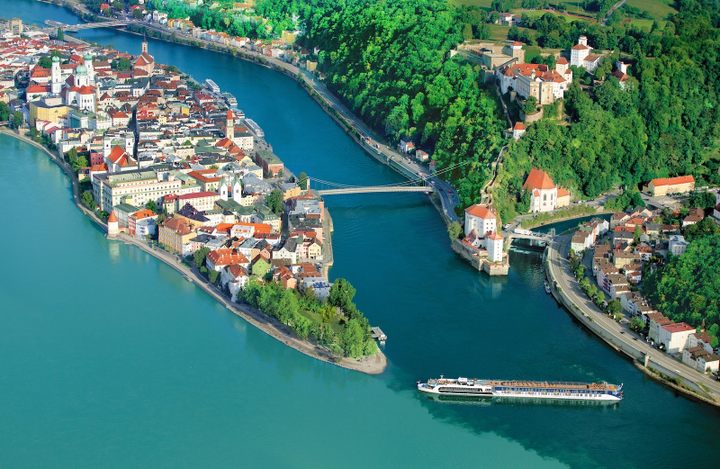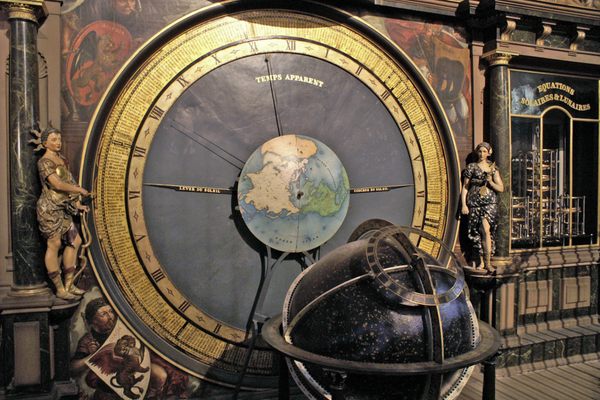
Explore Historical Wonders and Modern Curiosities Along the Danube
Discover the untapped world of Europe’s second longest river.
Once a frontier for the Roman Empire and also crucial to the evolution of Central Europe, the Danube is brimming with history. Its upper portion travels between Hungary and Germany, passing through some of the region’s most remarkable cities and towns. From a secret labyrinth that once held Vlad the Impaler, to a stunningly ornate library with the only public globe museum on the planet, AmaWaterways’ seven-night Melodies of the Danube cruise cruise will transport you to hidden gems along this storied river. Here are 10 spots to take you beyond the ordinary on your next port stop.
BUDAPEST, HUNGARY
Hungary’s capital city, Budapest is known for its thermal spas and architecture spanning from Baroque to Bauhaus, but tucked within the city’s rich history is where you’ll uncover some of its most alluring finds.

Castle Hill
For a true sense of Budapest’s history, head out on an AmaWaterways included excursion to Castle Hill, located in Buda on the Danube’s undulating west bank. Not only is this the oldest part of Hungary’s capital, but at its heart is Buda Castle, an 18th century Baroque palace that King Béla IV first constructed as a military fortress in the mid-13th century. In the centuries since, this massive royal residence has been added to, destroyed, and rebuilt six different times. Today it houses several museums, including one devoted to the city’s turbulent 2,000-year history and another showcasing Hungarian art—including a collection of Gothic altars from the 15th and 16th centuries. The larger palace complex includes Fisherman’s Bastion, with its seven fairytale-like turrets representing the seven Hungarian tribes who founded the present-day country in 895. Beneath the hill lies a huge labyrinth of underground caves and tunnels that travelers can visit. Vlad the Impaler (a.k.a. Dracula) was once even held captive here.
Vajdahunyad Castle
Although Budapest’s Vajdahunyad Castle oozes romance today, it was originally a fleeting design piece constructed of cardboard and wood. Hungarian architect Ignác Alpár created the structure for the country’s 1896 Millennial Exhibition, which marked the 1,000th anniversary of crowning the first Hungarian king. However, Hungarians were so enamored with its beauty that Alpár agreed to draw up permanent plans, this time using stone and brick. Rebuilt between 1904 and 1908, this incredibly unique complex is divided into four sections, each with its own architectural style: Renaissance, Romanesque, Baroque, and Gothic. The latter is considered by many to be its most alluring—modeled on Romania’s Corvin Castle—though the overall structure is actually an architectural homage to 21 different landmark buildings throughout the Hungarian kingdom, with some being more visible than others. Don’t miss the bust of Hungarian-American actor Béla Lugosi, famous for portraying Dracula, on the castle’s side exterior. German artist Hartmut Zech sculpted the piece, then snuck it onto the facade during a late night jaunt in 2003.
Shoes on the Danube Promenade
By giving a voice to events that shaped history, we not only commemorate the past, but keep our mistakes front and center in efforts to not repeat them. In 1944, Hungary’s fascist Arrow Cross Party shot and killed 3,500 people (800 of whom were Hungarian Jews) on the edge of the Danube River, after ordering them to remove their shoes. Though their bodies fell into the water and floated away, the “Shoes on the Danube Bank” memorial serves as a stark reminder of the event and the many lives lost. Hungarian film director Can Togay and local sculptor, Gyula Pauer, partnered to create this chilling monument, which consists of 60 pairs of period-appropriate iron shoes, from strapped heels and workman’s boots to loafers and flats. Erected in 2005, the shoes are attached to the stone embankment on the Pest side of the river, casually arranged as if in haste, and as a stirring reminder of what was left behind.
BRATISLAVA, SLOVAKIA
A sovereign state since 1992, Slovakia is brimming with castles, caves, and plenty of unspoilt wilderness. But it’s Bratislava, an inviting capital city with a well-preserved Gothic center and a small town feel, that really draws crowds.

Coronation City
When the Ottoman Empire captured Hungary’s eastern region in the 16th century, Bratislava became its capital city. From 1563 until 1830, it also served as the Kingdom of Hungary’s coronation city. AmaWaterways honors this regal past with an included “Coronation City of Kings” walking tour. Or, you can follow the same procession route that 10 kings, one queen, and seven royal wives of the Habsburg Dynasty took through Bratislava (then Pressburg) following their crowning on your own self-guided outing. Begin your journey at St. Martin’s Cathedral, a three-nave Gothic church that still stands on the city’s western border below Bratislava Castle, and just look for the series of small brass markers, each one sporting a crown emblem, that are hammered into the paving stones. You’ll wind your way through the narrow streets of Old Town to Bratislava’s main square. Each June, a bevy of costumed reenactors even takes on the ceremony’s major roles and reenact the coronation themselves. Look closely and you’ll see the Archbishop of Esztergom, who oversees the ceremony, and Emperor Maximilian II, the first monarch to be crowned within the city.
‘The Six White Mice’
The circus is always in town at Bratislava’s Eurovea Galleria, a shopping center that’s home to some of the city’s most intriguing public art. English artist Colin Spofforth, whose works also adorn public spaces in Bucharest and London, sculpted this series of 11 bronze circus performers—based on an original fairytale by his wife called The Six White Mice—in 2013. The story tells a tale of a magical troupe of circus performers, two children, and six white mice, all of whom are revolting against a greedy tyrant. Both inside and outside the galleria, keep an eye out for impressive figures like the eccentric Ring Master, stilt-walking Olga and her fire-eating partner Pat, and Isabelle, who just happens to be walking a tightrope across the second floor atrium.
AUSTRIA
Bucolic country towns nestled among alpine summits, impressive palaces, and Vienna, an architectural masterpiece where classical music and culture reign supreme.

Österreichische Nationalbibliothek (Vienna, Austria)
A bibliophile’s dream, Vienna’s Austrian National Library is also an ornate showcase of baroque mastery. As the country’s largest library, this stunning structure features more than 12.5 million books and artifacts spread among various collections, some that date back to the 14th century. Its centerpiece is the State Hall, with a fresco-covered dome ceiling rising up 65 feet above walnut bookcases filled with more than 200,000 historical works. The library itself is part of Vienna’s sprawling Hofburg Palace complex, right in the middle of Old Town, and features various museums, including one devoted to papyrus, as well as the only public globe museum on the planet and the Esperanto Museum, detailing the history of language invention worldwide. Keep an eye out for library employees utilizing hidden passages behind bookcases—an efficient way to get around the massive space.
Kunstkammer Wien (Vienna, Austria)
For a one-of-a-kind assemblage of unusual items, pay a visit to Vienna’s most prominent ‘cabinet of curiosities’. One of the most important dynasties in European history, the Habsburgs ruled Austria from 1282 until 1918. This royal family also amassed an almost encyclopedic collection of over 2,000 treasures spanning more than 1,000 years of history. Meant to showcase the family’s influence and prestige, this ‘chamber of art and wonder’ includes objects like a Dragon Bowl made from deep-blue lapis lazuli, a musical clock in the shape of a ship, and a 17th century “Narwalhornbecher,” originally claimed to be made from a unicorn horn (it’s actually a narwhal tusk). The collection’s most valuable object is “Saliera,” a 16th century salt cellar that Italian sculptor Benvenuto Cellini created for the then-king of France. Estimated to be worth about $65 million, it has its own unique story.
Achleiten panoramic trail (Weissenkirchen, Austria)
Take in the beauty of Austria’s Wachau Valley along a 2.4 mile-long circular route of back roads and vineyards. Leaving from the riverside village of Weißenkirchen, the largest wine growing community in the UNESCO-listed valley—an area well known for its Riesling—the trail meanders past the huts of local winegrowers and wayside shrines called ‘Marterls,’ often recognizable by a single post and a niche sporting a statue of Jesus or Mary. Savor panoramic views of rolling green hillsides and the Danube River as you go.
GERMANY
Just across the Austrian border into Germany, the district of Passau possesses a remarkably picturesque perch at the southern foothills of the Bavarian Forest mountains, and where a trio of rivers—the Danube, Inn, and Ilz—converge.

Europe’s Largest Pipe Organ (Passau, Germany)
Bask in the music of Passau’s St. Stephen’s Cathedral, home to one of the largest pipe organs on the planet. Pieced together over the centuries after fire destroyed both the cathedral and its original organ in 1662, this enormous musical instrument consists of 17,774 pipes, 223 registers, and four chimes. It’s actually made up of five separate organs, each with its own unique tone. They’re situated throughout the church and can be played separately. However, the master organist can also play them together from a central console, which has a programmable setter capable of storing more than 4,000 variations. This allows for a nearly infinite assortment of ranges and tones. Concerts take place most days at noon, May through October.
Schweiklberg Monastery (Vilshofen, Germany)
Perched above the small Bavarian town of Vilshofen sits what looks like a fortified church from the medieval era, but it’s actually a monastery that welcomes visitors. Built between 1905 and 1925, German architect Michael Kurz designed the structure, which includes a set of twin towers rising above the Danube, an Art Nouveau chapel, and an extensive library with more than 150,000 books. Along with being a training space for Benedictines—a religious order of Catholicism—Schweiklberg is also home to an Africa museum containing over 800 pieces of traditional African art and ethnography, all brought back by missionaries returning from countries like Kenya, Tanzania and South Africa. What’s more, the monastery is sole producer of Schweiklberger Geist, an herbal medicine used for nausea, coughs, and sleep disorders. It’s made onsite, and can be purchased in the monastery gift shop. Vilshofen proper is worth spending some time in as well. AmaWaterways even hosts an Oktoberfest celebration here exclusively for cruise guests. The festivities take place year-round.
Sponsored by AmaWaterways. Click here to explore more.






Follow us on Twitter to get the latest on the world's hidden wonders.
Like us on Facebook to get the latest on the world's hidden wonders.
Follow us on Twitter Like us on Facebook